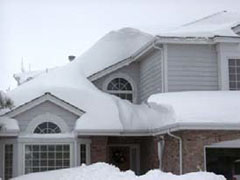Heavy snow accumulation has led to a wave of roof collapses in your area. With the threat of more snow on the horizon, you may want to consider clearing your roofs and decks to minimize the likelihood of a structural collapse. To help prevent major damage as well as save money and stress this winter, please follow these guidelines:
- When snow buildup occurs, use a roof rake with an extended handle to pull snow of the roof from the safety of the ground.
- Start from the edge and work your way into the roof using downward strokes.
- There’s no need to scrape the roof entirely clean, as this can damage your roof shingles or other roof covering.
- Metal roof rakes conduct electricity, so use caution near power lines.
- Avoid using a ladder; its rungs can freeze and cause you to slip. Instead of a ladder, buy extension poles or a longer roof rake.
- Roof snow removal can be dangerous. Hire a professional snow removal service if you need help.
- Removing roof snow can also prevent ice dams. Ice dams can form when roof snow melts and refreezes in gutters, clogging them. As more snow melts, water is forced to travel under shingles and can leak into the house. Keep gutters and downspouts clean and clear all the way to ground level during winter months.
If you have questions about your home coverage, please contact your Farm Bureau Insurance agent.
When should I remove the snow off my roof?

For those of you that are wondering “When should I remove the snow off my roof?” Here is a quick rule of thumb to help you if you are concerned.
Basic calculation (for a quick analysis only)
This calculation is based on a 25% moisture density which may be conservative for our current snow fall. As a rule of thumb, saturated snow weighs approximately 20 pounds per cubic foot. The moisture content of snow can range from approximately 1% to 33%, which relates to snow potentially weighing from 1 pound per cubic foot to over 21 pounds per cubic foot.
Calculation: S x 1.25 = P where…
S = Inches of snow on the roof (depth)
1.25 = Weight of 1 sq ft of snow for each 1-inch of depth
P = Pounds per square foot (lbs/sq ft)
Example: If the snow on my roof is 20-inches deep, what would that equate to?
20-inch roof snow depth x 1.25 lbs/sq ft = 25 lbs per sq ft of roof snow load
In this example the roof would be ok.
Note: Any ice build-up on the roof would need to be added to this formula. Add 5.2 lbs for each 1-inch of ice depth.
You can always check your roof snow load by cutting a 1-foot x 1-foot square the full depth of the snow from your roof and weighed in a plastic bag to determine if your snow load is getting close to the design roof snow load of 40 lbs per square foot. This would need to include any roof ice build-up also.
Flat roofs are more of a concern (less than 3/12 pitch). Flatter roof pitches tend to hold more snow moisture. With excessive rainfall, the weight of the roof snow can increase rapidly. If your structure is in question, it is best to consult an Idaho licensed engineer.
Please be aware of the potential dangers of shoveling or raking snow from a roof. Besides the potential damage to the roofing materials and structure, there are such factors as a person sliding off the roof, falling off a ladder, overexerting themselves, or injury from snow sliding on top of them.